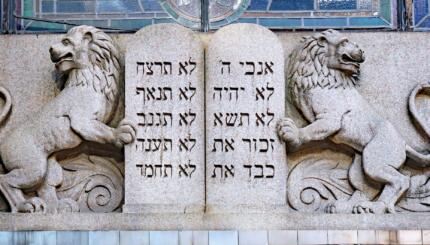Reprinted with permission from Jerusalem: Portrait of the City in the Second Temple Period (Jewish Publication Society).
Defining Sectarianism
A notable development in Hasmonean times was the emergence of identifiable religious sects. The term “sect” requires some clarification, as it usually is used in regard to Christian groups that periodically broke way from the Church for social and ideological reasons. In this period, only the Essenes of Qumran come close to fitting that definition.
Other groups, such as the Pharisees, Sadducees, Hasidians of Maccabean days, Sicarii, and early Christians, all operated in Jerusalem and wider Judean society and were not a priori opposed to the religious establishment. The term “sect” is thus not the most appropriate for our historical context. Nevertheless, we have retained it out of convenience, since it is universally used with reference to these groups.
When Did Second Temple Sects Begin?

With your help, My Jewish Learning can provide endless opportunities for learning, connection and discovery.
All evidence points to the beginning of the Hasmonean era [2nd century BCE] as the time when the number of Second Temple sects crystallized. While some scholars have posited the existence of these sects, or perhaps more accurately proto‑sects, as early as the fourth and third centuries, such theories are entirely speculative as there are no data to substantiate them.
Josephus [historian, soldier and political figure (1st century CE)], however, first mentions the existence of sects in the middle of the second century, and the development of the communal, sectarian center in Qumran can be dated to its latter half [… ] [Qumran, a settlement on the shores of the Dead Sea, served as headquarters for the Essenes in Second Temple times and is currently a major archeological site.]
Why Did Sects Form?
Religious sectarianism was indeed an unusual occurrence within ancient Judaism. Neither before the second century B.C.E. nor after 70 C.E. did the same range of organized sects exist among Jews, and thus the situation that first crystallized under the Hasmoneans was indeed sui generis. The historical circumstances of the middle second century would seem to have been most conducive for spawning such groups. This was indeed a time of transition and upheaval. Jewish society had been coping for decades with the attractiveness, threat, or both of Hellenism, a process […] that culminated in the transformation of Jerusalem into a polis in 175.
Following the trauma of Antiochus’ persecutions [Antiochus IV (ruled 175-164 BCE) forced Jews to abandon key Jewish practices and adopt Greek ways], and the desecration of the Temple [Antiochus IV consecrated the Temple to Zeus], the emergence of the new Hasmonean society was undoubtedly viewed by many with exhilaration and pride but by others, perhaps, with disdain and a source of profound disillusionment.
Some may have been alienated by the effects of urbanization; by the awareness of Hellenistic influences that, instead of being checked, were now making ever‑greater inroads under the Hasmoneans; by the Hasmonean usurpation of the high priesthood and the family’s problematic behavior (to some) in that position; by the overly ambitious military designs and increasingly centralized authority achieved by the Hasmoneans; by their combining of political and religious roles; and by the emergence of a vigorous anti-gentile policy.
Some or all of these factors may account for the creation of alternative religious groupings, principal among which were the above‑mentioned sects. Since there were striking differences among these sects, it is likely that many of the factors listed above (and others as well) played varying roles in the formation of each.
Sects and the City
Jerusalem was the focus of much of this sectarian activity. The Sadducees, by virtue of their being priests and involved in Temple affairs, were clearly based in the city. So, too, were the Pharisees […] The struggle between the Pharisees and Sadducees throughout this period seems to indicate that each group was well represented in Jerusalem. Moreover, while the Essenes were concentrated in the Judean Desert, they also had a foothold throughout the country and in Jerusalem as well.
Commonalities Among the Sects
The various sects in Hasmonean Jerusalem shared a number of characteristics with one another, although they also differed in significant ways. We will deal with these similarities and differences, respectively. Common to the groups was the fact that they were all voluntary frameworks. People searching for religious messages and inspiration may have become acquainted with several sects over the course of time and, as a consequence, were exposed to a series of religious figures and frameworks, as did Josephus in relating his own experience in the first century C.E.
These sects were neither cut from one cloth nor large in number. Not all priests were Sadducees or Essenes, and not all Essenes were priests. Moreover, the early Pharisees do not appear to have had any one particular social trait in common. However, most members of the sects, especially among the leadership, seem to have hailed from the socially, economically, and religiously established classes of Jerusalem society. The prominence of both the Sadducees and Pharisees in John Hyrcanus’ court [he was a Hasmonean ruler from 134 to 104 BCE] is a striking case in point.
The small size of these groups is attested by the fact that even during Herod’s rule [37-4 BCE] the Pharisees numbered only some six thousand, and in the first century there were approximately four thousand Essenes. The Essene communal site at Qumran, specifically its dining area, could accommodate perhaps as many as two hundred members at any one time and roughly indicates the sect’s size. The Sadducees, for their part, were even fewer in number, if a comment by Josephus regarding the first century C.E. may be considered relevant to the Hasmonean era.
Identity, Purity, and Boundaries
In choosing to belong to one particular sect, individuals were establishing their personal and collective identity vis-à-vis others. Thus each sect meticulously erected walls around itself to separate its members from other sects, ordinary Jews, and non‑Jews. This social separation was rigorously mandated and articulated in a variety of ways.
The Essenes residing in Qumran expressed this tendency in the extreme. The guidelines for entry into this sect, as well as the harsh punishment meted out to those who failed to keep its rules, indicate the determination to maintain communal standards at all costs. The Pharisees as well tended to separate them selves from the masses in certain crucial areas. The laws dealing with the havurah [community] with its stringent rules of both membership and separation from ‘am ha‑aret (the ordinary Jew), are a case in point. For both the Qumran Essenes and the Pharisees, one of the crucial means of maintaining this separation was through the strict observance of purity rules.
The need for constant purification was always present, as the miqva’ot (ritual baths) of Qumran and the attestations of Josephus and the scrolls repeatedly emphasize. Part of the daily ritual of the Essenes in general, and particularly at Qumran, was immersion before the communal meal and the liturgy that accompanied it. These purity regulations, which differed in many aspects from one sect to the other, probably served to restrict any kind of social contact with those outside one’s group.
Law and Study
With the publication of several halakhic [legal] scrolls and fragments, we have become more aware of late of the degree to which Jewish law was a pivotal factor in the self‑definition of the sects, as reflected in rabbinic literature. This has helped refocus attention on the importance of legal matters–and not only theological issues–in defining and distinguishing these groups.
Another common feature of the sects, at least regarding those for which we have information, is the centrality of study. The Pharisaic emphasis on this activity is reflected in both the statements found in Avot and the repeated claim made by Josephus that this group excelled in its precise knowledge of the Law. At Qumran, study was an ongoing activity throughout the day and night.


